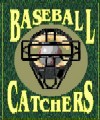 |
|
 |
|
|
will not move toward the right handed hitter nor away from the left handed hitter. His back foot will end up where his backside started, while his front foot will end up where his glove started. A common error is for the catcher to move towards his glove and fall off balance. The catcher should assume a pole is running through the middle of his body. He wants to shift around the pole, not spin away from it. Another key is to make sure the catcher does not stand straight up on his first movement. Stay low and in a strong, athletic position. This will assist the catcher in staying on top of the baseball and throwing downhill toward the base. If a ball is thrown right down the middle of the plate or towards the backhand, a catcher that possesses arm strength will utilize the load and throw. Catch the baseball while shifting weight to the back leg. Again, the catcher must square his body to second. The catcher must still utilize a quick glove/hand exchange with the baseball and stay low to the ground in a strong, athletic position. The catcher must get into a position where weight is on the back leg and the shoulders are squared to the base to which he is throwing. If the alignment is off, or the catcher has already stood up, the power that he possesses in his throwing arm will be lost. It is important to mention at this time that a catcher should be proficient in both skills. The location of the baseball will dictate which footwork will be used. The only exception is on a ball thrown to the middle of the catchers body. On this throw, the catcher will determine which throwing footwork will be best for him. THROWS TO THIRD BASE On pitches that take the catcher toward his backhand, the jab step is an appropriate throwing position. The catcher will simply take a jab step with his outside foot, plant his foot, stay low, point the shoulders to third, and make a strong and accurate throw. This will clear him from the hitter and give the catcher a lane to throw in. On a pitch that is down the middle, the catcher can use one of two methods, depending on whether there is a right or left handed hitter, and how tall the right handed hitter is in relation to the catcher. The catcher should plant his back leg, step towards third with the front leg and throw over the top of the hitter. The object is to have a lane to throw in without the hitter getting in the way and disrupting the throw. If the hitter is taller than the catcher or the pitch takes the catcher towards the glove hand side, the catcher can utilize a quick shuffle outside the hitter and create a throwing lane. Again, stay low, athletic, square the body to the base and make a strong and accurate throw to third. |
